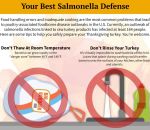Our food-safety regulations need a technological boost
By Lawrence Goodridge
June 25, 2018
Food contamination is like the weather; often difficult to predict. The current practice is to employ food management systems to control potential hazards during food production. However, even with such systems in place, contaminated food and the resulting outbreaks that are caused are far too commonplace. Like emerging approaches to weather prediction, employing the general public to improve the safety of the Canadian food supply may be the key.
The Canadian Food Inspection Agency recently announced the Safe Food for Canadians Regulations (SFCR), a major piece of legislation that aims to transform the way food is produced, imported and exported in Canada. A major aspect of the SFCR will require food suppliers, importers and exporters to improve traceability between suppliers and customers, a practice that is expected to lead to improvements in recalls of contaminated food. Yet, this approach highlights a major shortcoming of the SFCR.
Food-borne outbreak investigations in Canada and abroad are still based on surveillance systems in which a sick individual must seek medical care, and a specimen must be obtained and yield a disease-causing agent. However, many people who have food-borne illness do not seek medical care, and so public health officials often do not know about outbreaks for weeks or even months. All the while, the contaminated food remains in circulation, exposing more people to illness.
The situation is the same with food recalls. Food is often already at the retail level before it is determined to be contaminated and subsequently recalled. Yet, many Canadians are not aware of food recalls, increasing their chances of consuming contaminated food.
The approaches to food-borne outbreak investigations are passive; that is, solutions are not sought until after there are enough sick individuals to notify officials that a problem has occurred, increasing the risk of food-related illnesses in Canada. What is truly needed, and what the SFCR does not specifically address, is the need to move toward more pro-active responses to food safety, in which food-borne outbreaks are identified very early on, leading to faster removal of contaminated food from retail and decreasing the amount of Canadians who become sick.
This is where paradigm shifting weather-prediction approaches come in.
Checking the weather is among one of the first things that many people do each day. Yet, as we all know too well, the ability to accurately predict the weather remains challenging. However, a recent proliferation of smartphone apps is beginning to change the way weather forecasts are compiled, by combining the use of people and their locations, their phones and artificial intelligence algorithms, to develop reports on local weather patterns in real time. These approaches represent a paradigm shift toward a trend in which people are generating the very information they consume on a daily basis.
Traditionally, the view has been that consumers should not be considered as part of the food production continuum, despite the fact that most meals are still prepared and consumed at home, and many cases of food-borne illness occur as a result of improper food handling and preparation by consumers in their own kitchens.
Modern approaches to food safety should incorporate consumers to provide real- or near real-time information about the food they consume, allowing for food safety and public health officials to more rapidly and accurately track the sources of contamination. In the United States, several jurisdictions are beginning to embrace this approach.
Emerging technology such as artificial intelligence is allowing health departments to engage with the public to improve food-borne illness surveillance. For example, the New York City Department of Health and Mental Hygiene, and the Chicago Department of Public Health have recently begun to use social media and computer algorithms to identify food-borne illness complaints from consumers.
The website iwaspoisoned.com allows restaurant patrons to identify restaurants that may have served contaminated foods. While some may question the validity of allowing consumers to report on their own food-borne illnesses, such approaches represent pro-active ways in which outbreaks may be identified more quickly than current practices. Meaningful food safety legislation must take into account such novel approaches to food safety. Improving traceability of foods, while a necessary step, is simply not enough.
Lawrence Goodridge is an associate professor and director of the Food Safety and Quality Program in the Food Science and Agricultural Chemistry Department at McGill University.



